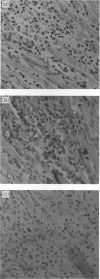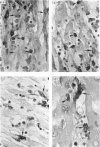Abstract
An immunohistochemical study of eosinophil distribution in the inflammatory cell infiltrates of four different types of myocardial lesions associated with Chagas' disease--caused by Trypanosoma cruzi--showed larger numbers of these cells in areas presenting tissue necrosis and degeneration, most notably in patients with the most severe myocarditis from a histopathological stand-point. Using antisera specific for human eosinophil-derived neurotoxin or eosinophil peroxidase, we detected deposits of these secretion products on myofibres and in the interstitium of chagasic myocardium displaying necrosis and degeneration but rarely in other types of lesions. These deposits were not detectable in the myocardium of non-chagasic patients who had died from myocardial infarction (acute or in the scarring stage) or myocarditis secondary to bacterial endocarditis. When human eosinophil-derived neurotoxin was incubated with myoblast monolayers there was a significant cell injury, detachment and lysis. These effects were abrogated by yeast RNA, added as a competitive ribonuclease substrate, and inhibited by the ribonuclease inhibitor RNasin, suggesting that the ribonuclease activity of the eosinophil-derived neurotoxin was involved in the effect. These results suggest a link between eosinophil infiltration and necrosis in chagasic myocardial lesions and point to EDN, and perhaps other toxic eosinophil secretion products, as possible mediators of tissue damage.
Full text
PDF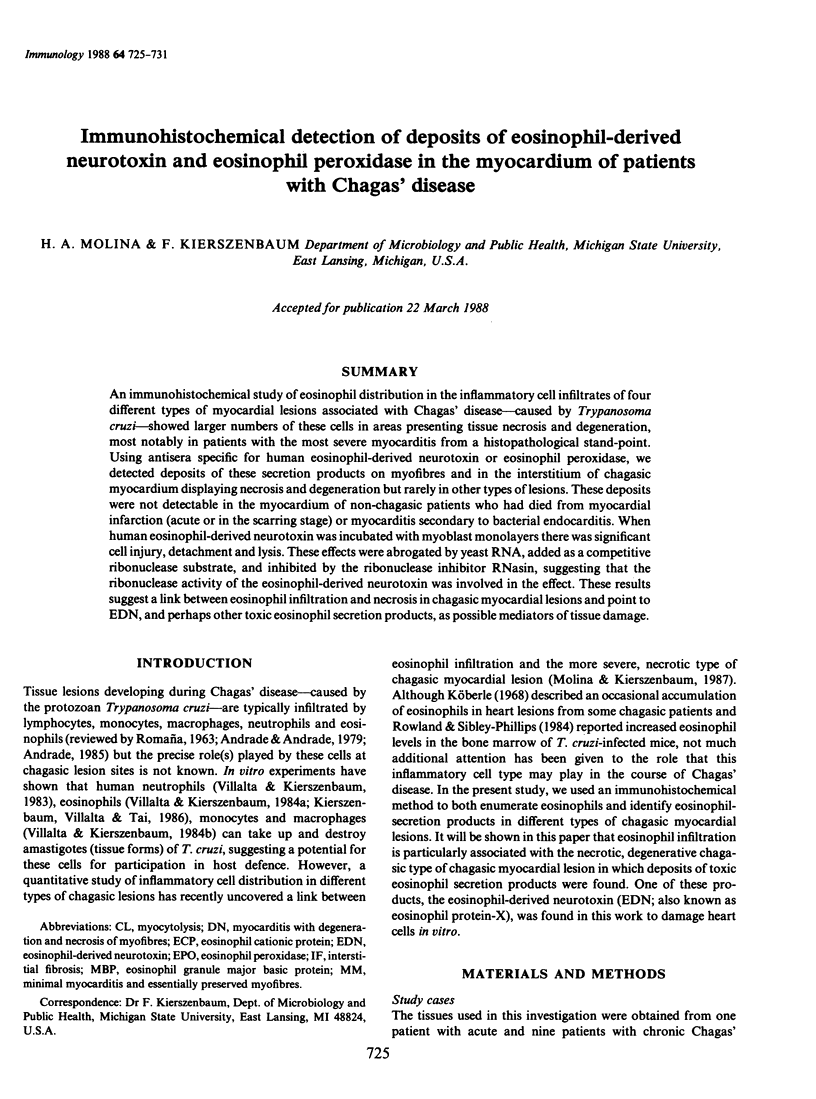


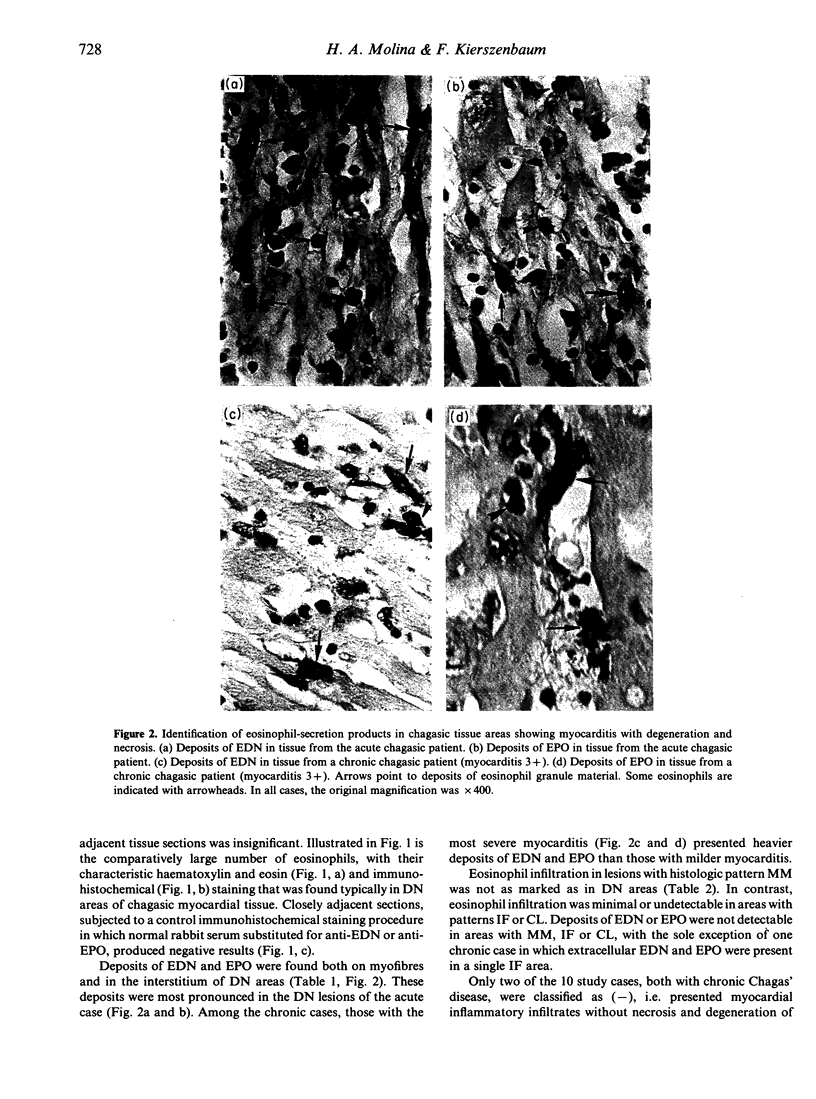
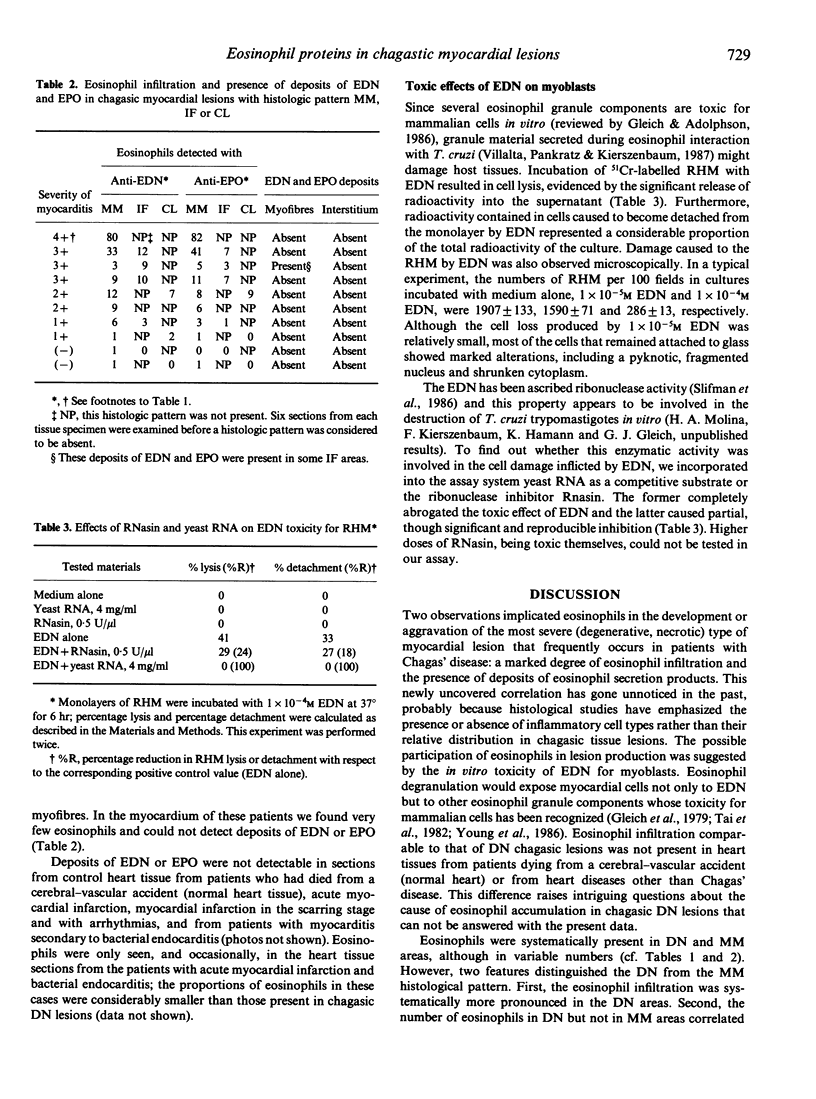
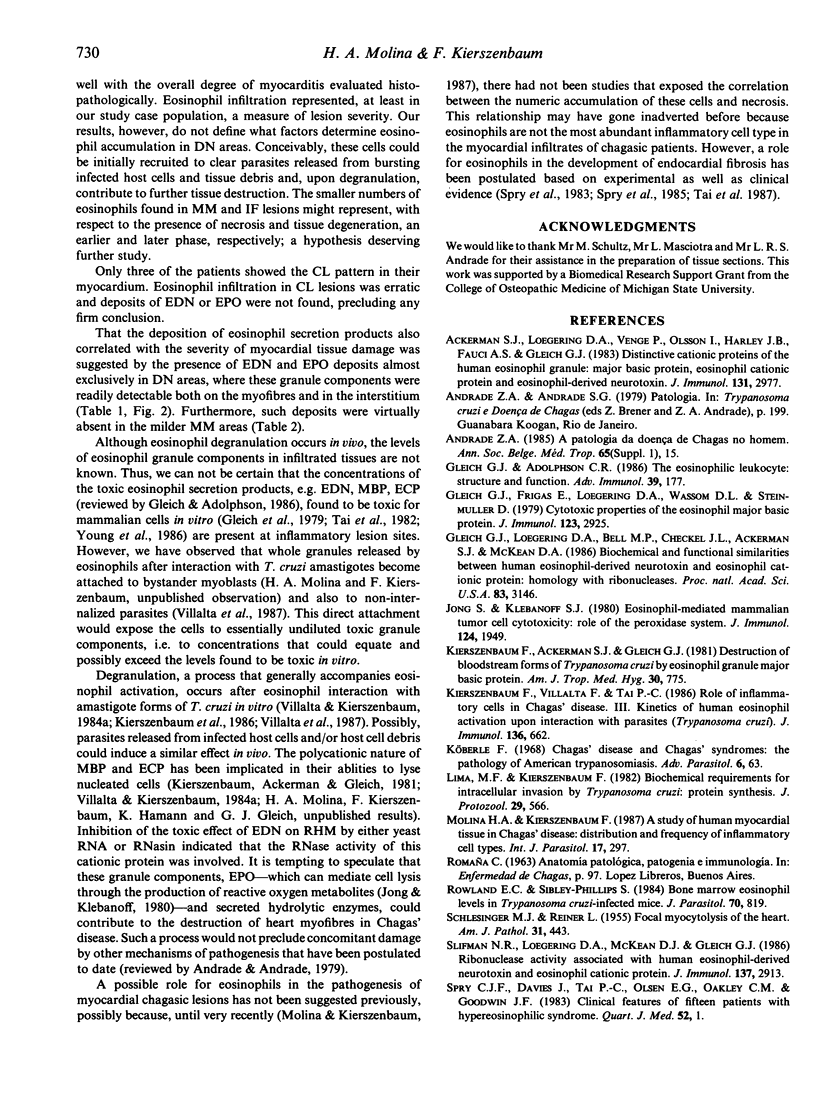
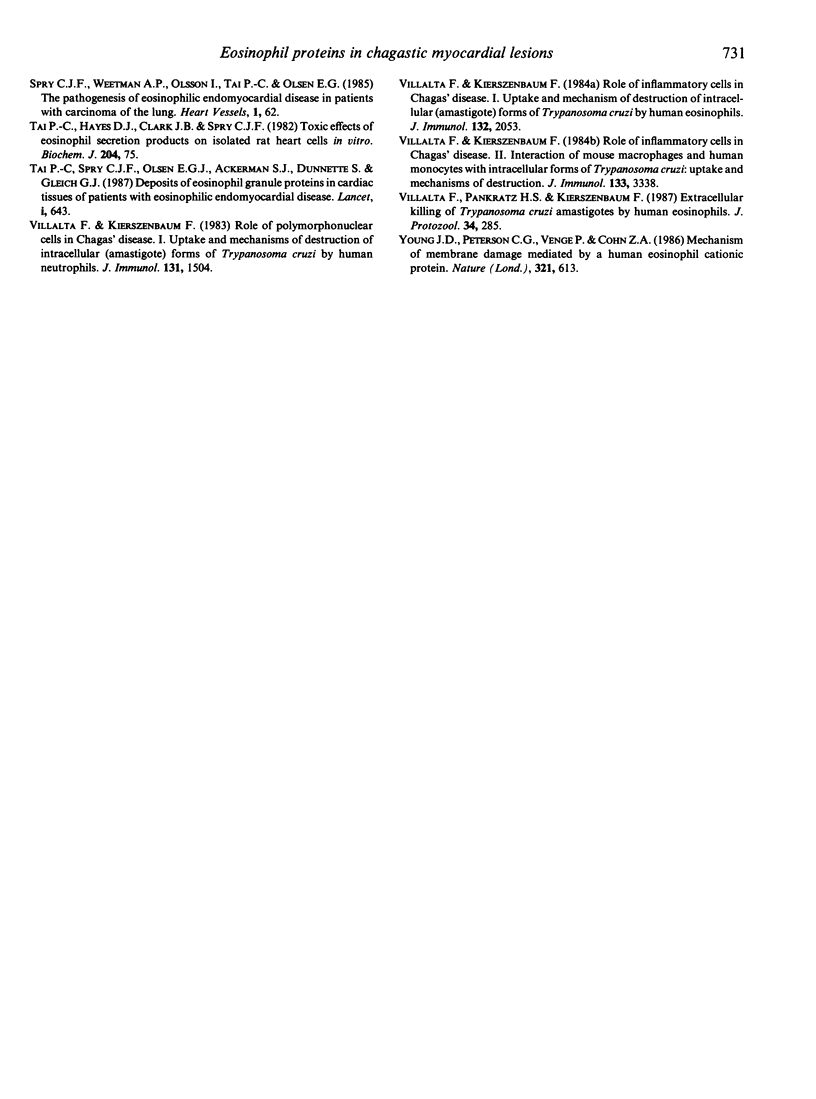
Images in this article
Selected References
These references are in PubMed. This may not be the complete list of references from this article.
- Ackerman S. J., Loegering D. A., Venge P., Olsson I., Harley J. B., Fauci A. S., Gleich G. J. Distinctive cationic proteins of the human eosinophil granule: major basic protein, eosinophil cationic protein, and eosinophil-derived neurotoxin. J Immunol. 1983 Dec;131(6):2977–2982. [PubMed] [Google Scholar]
- Andrade Z. A. A patologia da doença de Chagas no homem. Ann Soc Belg Med Trop. 1985;65 (Suppl 1):15–30. [PubMed] [Google Scholar]
- Gleich G. J., Adolphson C. R. The eosinophilic leukocyte: structure and function. Adv Immunol. 1986;39:177–253. doi: 10.1016/s0065-2776(08)60351-x. [DOI] [PubMed] [Google Scholar]
- Gleich G. J., Frigas E., Loegering D. A., Wassom D. L., Steinmuller D. Cytotoxic properties of the eosinophil major basic protein. J Immunol. 1979 Dec;123(6):2925–2927. [PubMed] [Google Scholar]
- Gleich G. J., Loegering D. A., Bell M. P., Checkel J. L., Ackerman S. J., McKean D. J. Biochemical and functional similarities between human eosinophil-derived neurotoxin and eosinophil cationic protein: homology with ribonuclease. Proc Natl Acad Sci U S A. 1986 May;83(10):3146–3150. doi: 10.1073/pnas.83.10.3146. [DOI] [PMC free article] [PubMed] [Google Scholar]
- Jong E. C., Klebanoff S. J. Eosinophil-mediated mammalian tumor cell cytotoxicity: role of the peroxidase system. J Immunol. 1980 Apr;124(4):1949–1953. [PubMed] [Google Scholar]
- Kierszenbaum F., Ackerman S. J., Gleich G. J. Destruction of bloodstream forms of Trypanosoma cruzi by eosinophil granule major basic protein. Am J Trop Med Hyg. 1981 Jul;30(4):775–779. doi: 10.4269/ajtmh.1981.30.775. [DOI] [PubMed] [Google Scholar]
- Kierszenbaum F., Villalta F., Tai P. C. Role of inflammatory cells in Chagas' disease. III. Kinetics of human eosinophil activation upon interaction with parasites (Trypanosoma cruzi). J Immunol. 1986 Jan;136(2):662–666. [PubMed] [Google Scholar]
- Köberle F. Chagas' disease and Chagas' syndromes: the pathology of American trypanosomiasis. Adv Parasitol. 1968;6:63–116. doi: 10.1016/s0065-308x(08)60472-8. [DOI] [PubMed] [Google Scholar]
- Lima M. F., Kierszenbaum F. Biochemical requirements for intracellular invasion by Trypanosoma cruzi: protein synthesis. J Protozool. 1982 Nov;29(4):566–570. doi: 10.1111/j.1550-7408.1982.tb01337.x. [DOI] [PubMed] [Google Scholar]
- Rowland E. C., Sibley-Phillips S. Bone marrow eosinophil levels in Trypanosoma cruzi infected mice. J Parasitol. 1984 Oct;70(5):819–820. [PubMed] [Google Scholar]
- SCHLESINGER M. J., REINER L. Focal myocytolysis of the heart. Am J Pathol. 1955 May-Jun;31(3):443–459. [PMC free article] [PubMed] [Google Scholar]
- Slifman N. R., Loegering D. A., McKean D. J., Gleich G. J. Ribonuclease activity associated with human eosinophil-derived neurotoxin and eosinophil cationic protein. J Immunol. 1986 Nov 1;137(9):2913–2917. [PubMed] [Google Scholar]
- Spry C. J., Davies J., Tai P. C., Olsen E. G., Oakley C. M., Goodwin J. F. Clinical features of fifteen patients with the hypereosinophilic syndrome. Q J Med. 1983 Winter;52(205):1–22. [PubMed] [Google Scholar]
- Tai P. C., Ackerman S. J., Spry C. J., Dunnette S., Olsen E. G., Gleich G. J. Deposits of eosinophil granule proteins in cardiac tissues of patients with eosinophilic endomyocardial disease. Lancet. 1987 Mar 21;1(8534):643–647. doi: 10.1016/s0140-6736(87)90412-0. [DOI] [PubMed] [Google Scholar]
- Tai P. C., Hayes D. J., Clark J. B., Spry C. J. Toxic effects of human eosinophil products on isolated rat heart cells in vitro. Biochem J. 1982 Apr 15;204(1):75–80. doi: 10.1042/bj2040075. [DOI] [PMC free article] [PubMed] [Google Scholar]
- Villalta F., Kierszenbaum F. Role of inflammatory cells in Chagas' disease. II. Interactions of mouse macrophages and human monocytes with intracellular forms of Trypanosoma cruzi: uptake and mechanism of destruction. J Immunol. 1984 Dec;133(6):3338–3343. [PubMed] [Google Scholar]
- Villalta F., Kierszenbaum F. Role of polymorphonuclear cells in Chagas' disease. I. Uptake and mechanisms of destruction of intracellular (amastigote) forms of Trypanosoma cruzi by human neutrophils. J Immunol. 1983 Sep;131(3):1504–1510. [PubMed] [Google Scholar]
- Villalta F., Pankratz H. S., Kierszenbaum F. Extracellular killing of Trypanosoma cruzi amastigotes by human eosinophils. J Protozool. 1987 Aug;34(3):285–290. doi: 10.1111/j.1550-7408.1987.tb03176.x. [DOI] [PubMed] [Google Scholar]
- Young J. D., Peterson C. G., Venge P., Cohn Z. A. Mechanism of membrane damage mediated by human eosinophil cationic protein. Nature. 1986 Jun 5;321(6070):613–616. doi: 10.1038/321613a0. [DOI] [PubMed] [Google Scholar]



